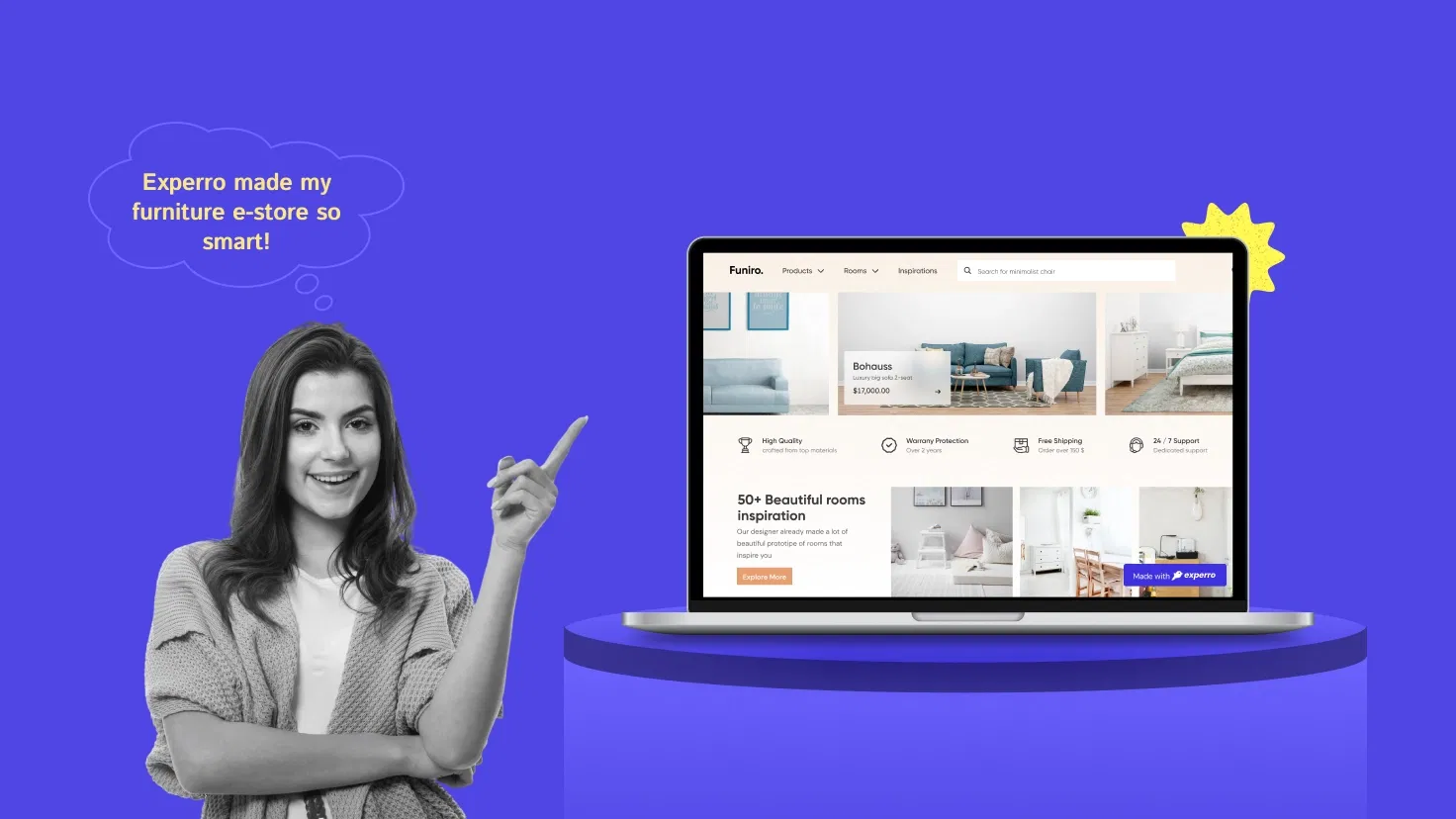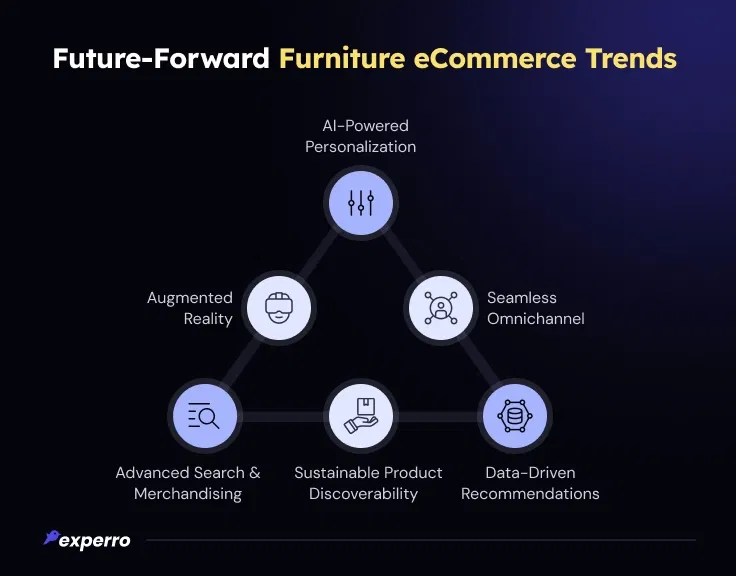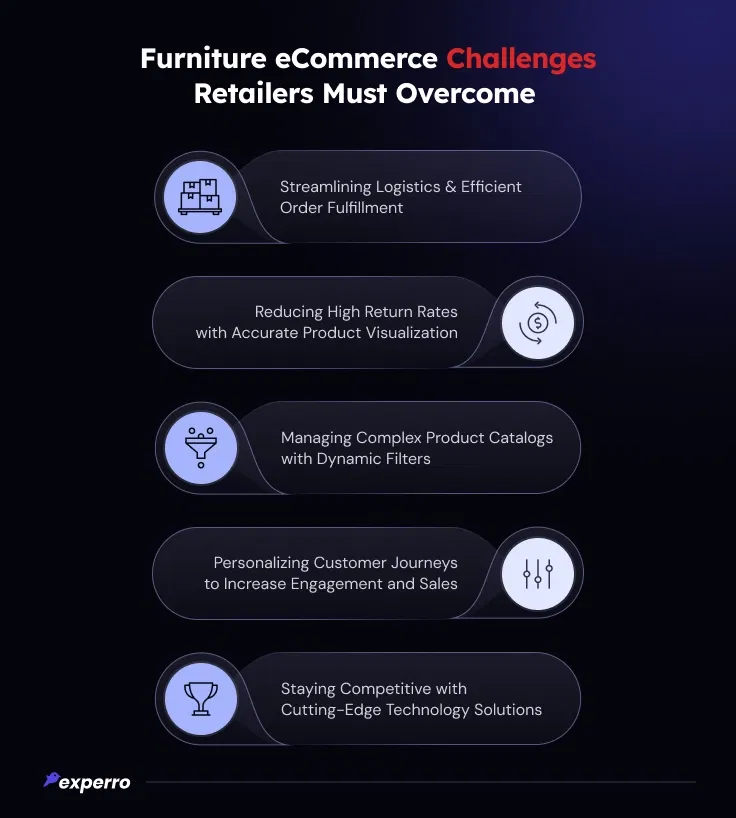Furniture eCommerce Trends to Grow Your Sales By 89% in 2025

What’s Inside
- What is Furniture eCommerce?
- Factors Driving the Growth of the Online Home Decor Market
- How Are the Furniture eCommerce Trends Evolving in 2025?
- What Are the Key Features for Online Furniture Stores?
- What Are the Best Practices for Furniture eCommerce Websites?
- What Are the Top Furniture eCommerce Challenges Retailers Must Overcome?
- What Are the Top Furniture eCommerce Website Examples?
- Scale Your Furniture Brand with Experro’s Agentic Solution
- Concluding Thoughts
Key Takeaways
- Furniture eCommerce is shifting toward faster, smarter, and more personalized customer experiences.
- Product details and high-quality visuals are essential to reduce returns and boost buyer confidence.
- A scalable catalog strategy is critical for handling large inventories and rapid product changes.
- Experro can empower your furniture brand to stay ahead with AI-driven discovery, fast site performance, and headless flexibility.
Is your furniture brand ready for the future?
The way people buy furniture online has changed forever. The furniture eCommerce revolution is in full swing, from browsing bulky catalogs to virtually placing a sofa in their living room.
As consumer expectations evolve, eCommerce retailers like you must stay ahead by embracing tech, trends, and experience-first design.
Wondering how to keep your brand relevant in this fast-moving space? Let’s explore the biggest furniture eCommerce trends for 2025 and what it takes to thrive in the online market.
What is Furniture eCommerce?

Furniture eCommerce is the buying and selling process of furniture products through digital storefronts.
This model enables businesses to showcase vast inventories online, supported by rich visuals and customer reviews. It covers everything from sofas and tables to lighting and home restoration furniture.
In recent years, the online furniture market has become a preferred space for customers due to convenience, variety, and hyper-personalization.
From click-to-cart to white-glove delivery—furniture eCommerce platforms now cater to every part of the customer journey.
Factors Driving the Growth of the Online Home Decor Market
Online home decor eCommerce is growing rapidly due to changing lifestyles and digital convenience. Modern buyers want access to style and comfort from their screens.
Key growth drivers include:
- Rising interest in smart and functional furniture is driving market growth, with projections reaching $4.66 billion by 2032.
- Demand for personalized and AI-assistant shopping experiences.
- Growing preference for online shopping is transforming the home furnishing market, expected to hit $313 billion by 2031.
- Growing trust in digital purchases through better product visualization.
- Expansion of home decor categories (wall arts, lighting, curtains, mirrors, etc.) catering to diverse aesthetics.
Now that we are well aware of the growth driving factors for the online furniture market, let’s dive deeper into the furniture e-store trends evolving in 2025.
How Are the Furniture eCommerce Trends Evolving in 2025?
As we look to the future of online furniture shopping, a few key technologies and eCommerce strategies will define success.

Let’s explore the top furniture eCommerce trends for 2025 shaping the home furnishing industry:
1. AI-Powered Personalization for Meaningful Product Discovery
According to the best furniture eCommerce trends for 2025, personalization goes far beyond calling users by their names.
Artificial intelligence (AI) will drive deeply contextual customer experiences—where the homepage, recommendations, and even product bundles adapt based on real-time browsing behavior.
Think — a user views a modern sofa, and the site instantly recommends matching coffee tables, rugs, and wall art.
Gen AI-powered personalization in banners, dynamic pricing, and one-to-one product journeys are turning generic stores into adaptive sales assistants.
This is the age of agentic experiences, where AI powers meaningful moments in every click.
2. Seamless Omnichannel Integration for Consistent Customer Journeys
Furniture shoppers expect continuity—whether they’re browsing on your e-store with their phone during lunch or visiting your physical store over the weekend.
Omnichannel eCommerce integration means users can discover a product online, check availability in-store, schedule delivery, and even track service—all within a single journey.
It’s not just about syncing data; it’s about creating emotional continuity across every touchpoint.
Coming forward, furniture brands that blur the lines between digital and physical will win the trust of convenience-driven buyers. The goal is simple: one customer, one experience, and many touchpoints.
3. Augmented Reality for Immersive Shopping Experiences
“Will this suit my drawing room space?” and “Will this match my room?”—AR answers both before purchase. Augmented reality allows users to project life-sized 3D furniture into their living spaces using just a smartphone.
This isn’t just fun tech, it’s key to driving informed purchase decisions. Customers can visualize scale, color harmony, and spatial alignment, helping reduce buyer hesitation and post-purchase returns.
In fact, AR has pierced through multiple industries, from virtual try-ons in fashion to AR in jewelry for visualizing rings or necklaces in real-time.
Additionally, AR in home decor eCommerce is becoming as important as product images in the path to purchase. In 2025, immersive decision-making will be the expectation, not the extra.
4. Advanced Search and Merchandising for Smarter Shopping
Shoppers don’t want to scroll endlessly— they want a platform that understands them and suggests results that match their intent. Advanced search in furniture eCommerce now includes AI-driven filters, voice search, and autocomplete that learns over time.
Digital merchandising becomes smarter too. The products shown are influenced by inventory levels, user behavior, and even trending seasonal styles.
Imagine a dynamic homepage where the layout and collections are updated in real time based on what’s hot or what’s running low. This year, smart merchandising is your silent sales rep, always optimizing in the background.
5. Sustainable Product Discoverability with Smart Filtering
Sustainability is more than a buzzword; it’s a buying factor. Customers seek ethically sourced, environmentally friendly options and expect transparency.
Smart eCommerce filters like “Made from recycled materials” or “Sustainably sourced wood” empower eco-conscious choices. Furniture brands showcasing their sustainability credentials directly in the product discovery journey stand out.
In a competitive space, values-driven navigation becomes a key conversion booster. Now, furniture e-stores will need to highlight sustainability as clearly as they do price or style.
6. Data-Driven Recommendations to Boost Conversion Rates
Every click, scroll, and pause tells a story—and smart brands are listening. Data analytics allow furniture eCommerce stores to optimize every element, from homepage layouts to checkout flows.
Want to know which fabric pieces lead to longer time-on-page? Or which price points get abandoned carts? That insight helps shape personalized promotions, better product placements, and improved UX.
Your data isn’t just a backend tool, it’s the secret sauce behind conversion rate optimization, customer-centric design.
That’s all about the home furnishing eCommerce trends. Now, let’s jump into the key features of online furniture stores.
What Are the Key Features for Online Furniture Stores?
To thrive in the eCommerce furniture business model, your furniture eCommerce website features must go beyond good visuals. It should deliver an intuitive, efficient, and personalized experience.

Let’s break down the must-have features of a furniture eCommerce platform:
1. Smart Product Search and Advanced Filtering System
A built-in intelligent search engine with advanced filtering capabilities allows users to quickly locate furniture based on material, color, style, price, and room type.
The system should include features like fuzzy search for typo correction, capturing online searches for furniture such as “modrn coffee tabel” and redirecting users to accurate results.
This feature enhances product discoverability, reduces bounce rates, and keeps shoppers engaged across diverse home décor categories.
2. Interactive Product Images with Zoom and 360-Degree View
High-resolution imagery combined with zoom functionality and 360-degree views gives customers a detailed look at textures, finishes, and dimensions.
This interactivity mimics the in-store experience, helping users make confident decisions without physical inspection.
It helps build trust, reduce uncertainty, and lower return rates— boosting sales in online furniture retail.
3. Secure and Flexible Online Payment Options
A secure checkout system is essential for building customer confidence. It should support encrypted transactions to protect sensitive data.
It should also offer multiple payment methods inclusing credit/debit cards, digital wallets, buy-now-pay-later solutions, and financing options.
This flexibility caters to different customer preferences and the typically high cost of furniture purchases, helping to build trust and drive higher conversion rates.
4. User-Friendly Navigation and Clear Product Categorization
The system should provide an intuitive navigation structure with multi-level menus that let shoppers explore categories like bedroom, living room, or dining, as well as by style or brand.
With well-defined product taxonomy and menus, this feature streamlines product discovery and enhances time-on-site, improving the overall shopping experience in your online furniture store.
5. AI-Driven Product Recommendations Based on User Behavior
The system should include a personalized recommendation engine that analyzes browsing history, preferences, and past purchases to deliver relevant suggestions.
This feature increases average order value and basket size and enhances user engagement by making the furniture shopping journey more relevant and enjoyable.
6. Responsive Design Optimized for Mobile and Desktop
A fully responsive storefront should offer seamless performance across mobile, tablet, and desktop devices.
The design prioritizes mobile-first eCommerce website features like swipe-to-view, voice search, and one-click checkout.
This feature enables a smooth and engaging shopping experience, regardless of screen size, and is critical to capturing mobile furniture shoppers.
Now that we have explored the features, let’s dive deeper into the best practices to follow furniture eCommerce trends.
What Are the Best Practices for Furniture eCommerce Websites?
In a competitive landscape, implementing furniture eCommerce best practices help you stand out.

Here’s what matters the most:
1. Leverage AI-Powered Personalization
Use machine learning to recommend products that match each shopper’s style and budget.
Gen AI-powered personalization strategy enhances both engagement and furniture eCommerce conversion rates by delivering highly relevant product suggestions, automating content variations, and adapting in real-time to customer preferences.
2. Streamline the Customer Journey with Advanced Search Features
Modern shoppers want flexible, fast ways to find furniture. Multimodal search combines text, voice, and image-based search to make discovery easier.
Whether they type a query, speak it, or upload a photo, customers get accurate results quickly. With features like conversational search and synonym recognition, this approach reduces friction and keeps users engaged.
3. Boost Engagement with Dynamic, Personalized Content
The customer will find things relevant through personalized banners, trending items, and profile-based recommendations based on their behavior.
These real-time updates respond to user preferences, nudging them towards products that they are more likely to buy. Content personalization is subtle but powerful way to increase engagement, session time, and conversions.
4. Create a Consistent Multi-Channel Shopping Experience
Today’s shoppers move quickly between mobile, desktop, and physical stores. Your furniture eCommerce platform should offer a connected experience across all channels.
Unified inventory, shared user profiles, and synced order history make browsing and buying furniture online seamless. This consistency builds trust, streamlines the journey, and meets the expectations of modern shoppers.
5. Leverage Data-Driven Insights for Smarter Decision-Making
AI in furniture eCommerce sites generate valuable data every second. Use it. From heatmaps and search trends in the furniture industry to bounce rates and click paths—let eCommerce analytics guide design updates, product curation, and marketing campaigns.
A data-driven strategy helps identify what’s working, what’s not, and where revenue opportunities lie. Smarter decisions lead to better outcomes across the board.
After exploring the best practices, let’s learn more about the key challenges and considerations that retailers must be aware of.
What Are the Top Furniture eCommerce Challenges Retailers Must Overcome?
Even with a thriving home furnishing business, certain roadblocks persist.

Let’s explore the top furniture eCommerce challenges.
1. Streamlining Logistics and Efficient Order Fulfillment
Bulky items, shipping costs, and long delivery windows make furniture fulfillment complex. Delays or poor tracking experiences can quickly erode customer trust.
Managing inventory, coordinating carriers, and handling returns require tight operational control. Without an efficient logistics setup, scaling becomes a challenge.
To help with this, Experro integrates seamlessly with fulfillment workflows, offering real-time inventory visibility and faster order processing to enhance delivery accuracy and customer satisfaction.
2. Reducing High Return Rates with Accurate Product Visualization
Furniture returns are often driven by mismatched expectations such as wrong size, color, or finish. Since shoppers can’t physically interact with products, visual clarity becomes crucial.
Customers are more likely to second-guess or return their purchases without accurate representations. High-quality images, 360-degree views, and AR help users make confident decisions.
That’s why Experro supports rich media and 3D visualization capabilities to help your customers see exactly what they’re buying before they click “buy”.
3. Managing Complex Product Catalogs with Dynamic Filters
Furniture catalog management is often massive and multi-layered, spanning categories, styles, materials, and dimensions. If users can't filter effectively, they leave.
Poor navigation can make even the best inventory feel overwhelming. Smart filters simplify the experience, helping shoppers find exactly what they want without frustration.
To solve this, Experro offers dynamic filtering and AI-powered faceted navigation. With this, users can quickly narrow down results based on what matters the most to them.
4. Personalizing Customer Journeys to Increase Engagement and Sales
Generic customer experiences don't work anymore in furniture eCommerce industry. Each shopper has unique preferences, styles, and budgets.
Without personalization, brands miss the chance to build deeper connections. Tailored recommendations, curated collections, and relevant content improve engagement and drive higher AOV.
However, Experro enables real-time personalization powered by user behavior, helping you create shopping journeys that feel custom-built for every visitor.
5. Staying Competitive with Cutting-Edge Technology Solutions
Furniture eCommerce retailers face growing pressure to keep up with evolving customer expectations and tech trends.
Falling behind means losing traffic and conversions to more agile competitors. From advanced search to omnichannel tools, the right tech stack makes all the difference.
That’s where Experro stands out—delivering AI-driven search, mobile-first design, and experience-led architecture to future-proof your furniture eCommerce business.
Now that we have explored the key challenges, let’s explore some of the top eCommerce websites for furniture eCommerce.
What Are the Top Furniture eCommerce Website Examples?
Let’s look at the best furniture eCommerce sites that not only operate at an enterprise level but also showcase strong eCommerce capabilities.
1. IKEA

IKEA pairs its minimalist appeal with a powerful digital ecosystem. Their app and site use AR in furniture eCommerce, real-time inventory, and visual search to enhance the experience.
They also offer planning tools that let users design entire rooms virtually. The seamless transition between mobile and in-store enhances omnichannel shopping.
IKEA’s focus on user control and personalization keeps online shoppers engaged from discovery to delivery.
2. Crate & Barrel

This brand offers curated collections and intuitive search. They’ve embraced furniture eCommerce trends like personalized browsing and digital look books.
Their “Inspiration” section blends lifestyle content with product recommendations, helping users visualize items in context.
Crate & Barrel also uses behavioral data to suggest products that match customer tastes. It’s a thoughtful blend of editorial style and smart commerce.
3. Article

Article stands out with its direct-to-consumer model and clean UX. They’ve built trust through high-quality visuals, detailed specs, and a transparent delivery process.
The platform emphasizes simplicity like limited SKUs, curated styles, and fast delivery windows. Their digital experience balances form and function, guiding users with clear messaging and effortless navigation.
Article proves that fewer choices can often mean better decisions.
4. Wayfair

Wayfair leads in tech-driven personalization. Their furniture eCommerce platform supports vast catalogs, smart filtering, and interactive product views. It’s a model for bedroom furniture trends in 2025 and beyond.
Their AI-powered home assistant offers real-time suggestions while browsing. Augmented reality, in-depth reviews, and room planning tools help convert interest into online furniture sales. Wayfair sets the bar for scalable, customer-first furniture experiences.
Scale Your Furniture Brand with Experro’s Agentic Solution

Experro is built to help you lead the future of digital furniture retail trends, as it provides:
- AI-powered search that delivers fast, accurate results even with vague queries.
- eCommerce merchandising that highlights trending, in-stock, and high-margin products using rules or AI.
- AI-powered recommendations that curate personalized furniture shopping experiences across channels.
- Headless architecture that builds modern, fast-loading tech-savvy furniture businesses without limitations.
- Data analytics that make smarter decisions using real-time customer behavior insights.
By bringing the power of AI in furniture eCommerce, Experro helps you personalize, optimize, and innovate at every step of the customer journey.
Ready to create your furniture eCommerce website without limits? Unlock new possibilities with Experro, an agentic experience platform for furniture stores that’s built for scale and innovation.
Concluding Thoughts
To stay relevant in the online furniture business, your brands must adopt the latest tech and consumer-first strategies.
From AI and AR to personalization and advanced search— latest furniture ecommerce trends for 2025 are set to be transformative. Following the right trends and best practices ensures long-term success in the home goods industry.
With the right platform, even the most traditional retailer can become a furniture eCommerce leader. If you're ready to elevate your brand experience—connect with our experts on a call.
FAQs


Pallavi Dadhich
25 April 2025Pallavi is an ambitious author known for her expertise in crafting compelling content across various domains. Beyond her professional pursuits, Pallavi is deeply passionate about continuous learning, often immersing herself in the latest industry trends. When not weaving words, she dedicates her time to mastering graphic design.